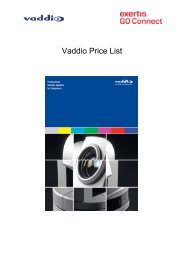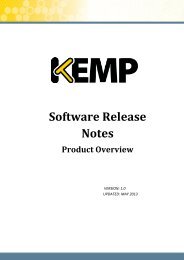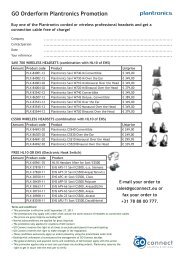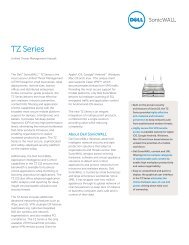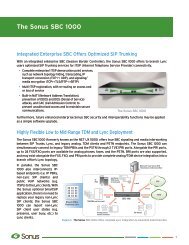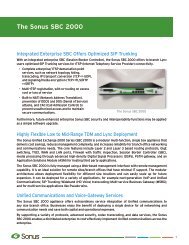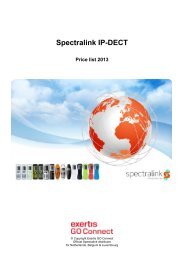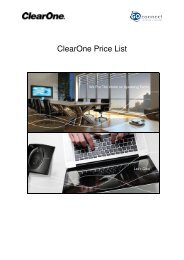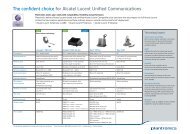Download - Sonus Networks
Download - Sonus Networks
Download - Sonus Networks
You also want an ePaper? Increase the reach of your titles
YUMPU automatically turns print PDFs into web optimized ePapers that Google loves.
<strong>Sonus</strong> Unified Exchange<br />
Next Generation Platform<br />
For Real-Time Services
SBC 2000 Series All-In-One Branch Office Networking Appliance With Integrated Application Services Module<br />
IVAR Benefits<br />
• Offers scalable architecture for all customer types –<br />
from smallbranch to large corporate datacenters<br />
• A modular customer premise equipment (CPE)<br />
packaged into a single box solution provides unique<br />
capabilities for invest-as-you-grow model enabling<br />
service up-sale<br />
• Solves integration problems with existing telecom<br />
equipment<br />
• Provides a true high capacity Any-to-Any switching<br />
through support for a wide choice of codec<br />
transcoding and protocol mediation<br />
• Reduces branch office deployment complexity with<br />
a single box form factor for both voice and data<br />
• Shortens applications deployment time and reduces<br />
cost - Powerful Applications Solutions Module allows<br />
VARs to host value added applications without<br />
needing a separate server hardware<br />
Customer Benefits<br />
• Multi-function appliance reduces both capital and<br />
operational expenses by eliminating the need to<br />
purchase a Router, a PSTN gateway, an SBC and<br />
an application server<br />
• Modular architecture allows customers to select only<br />
the options they need. Customers can choose to keep<br />
their existing routers or replace multiple devices with<br />
a single appliance<br />
• Highly secure User Interface simplifies management<br />
and configuration for Lync Server 2010 deployments<br />
• Integrated Application Solutions Module can be<br />
used for hosting 3rd party applications and reduces<br />
number of servers and IT management complexity<br />
• Built-in Session Border Controller ensures both<br />
voice and data applications are secure<br />
- Includes TLS, SRTP, IPSec for enhanced security<br />
- Mitigates against denial of service attacks<br />
- Provides Topology hiding<br />
• Web-based management, Syslog, and SNMP<br />
monitoring simplifies day-to-day management and<br />
operations<br />
• Active Directory/LDAP integration provides simplified<br />
deployment and management<br />
• Appliance form factor with hardened OS simplifies<br />
maintenance<br />
Overview<br />
The <strong>Sonus</strong> Unified Exchange 2000 (SBC 2000) is a modular multifunction,<br />
high performance mediation platform that delivers cost<br />
savings, reduces management complexity, and increases reliability<br />
for branch office networking and communications needs. The core<br />
features include Layer 2 and Layer 3 based routing protocols, GigE<br />
switching, T1/E1, WAN and LAN ports, Firewall with traffic inspection,<br />
Session Border Controller (SBC), media processing through advanced<br />
high-density Digital Signal Processors (DSPs), PSTN gateway, and an<br />
Application Solutions Module (ASM) for hosting third party applications.<br />
The SBC 2000 is fully managed using a highly secure Web-based management<br />
interface . It is an ideal solution for remote sites/branch offices<br />
that have minimal IT support. The modular architecture allows<br />
deployment flexibility for different size locations and can easily scale<br />
up for future expansion. It can be deployed for a variety of applications<br />
such as next-generation VoIP and Unified Communications; SIP<br />
Trunking; Wideband (HD Voice) transcoding; Muti-service Business<br />
Gateway (MSBG); and for multi-service applications like Pseudo-wire.<br />
Unified Communications (OCS R2, Lync Server<br />
2010) and Voice-Gateway Services<br />
The <strong>Sonus</strong> SBC 2000 appliance offers extraordinary service integration<br />
of Unified communications to any size branch office. Businesses<br />
enjoy the benefit of deploying a single device for all networking and<br />
communication needs and save both capital and operational expenses.<br />
By supporting a variety of protocols, advanced security, codec transcoding,<br />
and data services, the SBC 2000 enables a distributed enterprise<br />
to cost-effectively implement Unified communications across<br />
the enterprise.<br />
High performance mediation platform for UC &<br />
Enterprise SBC, qualified for Microsoft ® Office<br />
Communications Server (OCS) R2 and Lync <br />
Server 2010<br />
PSTN<br />
(Failover)<br />
ITSP<br />
SIP Trunking<br />
Service Provider Benefits<br />
• Modular and scalable architecture provides flexibility<br />
in designing the right Customer Premise Equipment<br />
for SIP Trunking<br />
• Microsoft OIP Qualification ensures Microsoft Lync<br />
Server 2010 deployment is supported by Microsoft<br />
• Support for a wide variety of TDM and IP based PBXs<br />
ensures smooth integration of Microsoft UC<br />
- Analog<br />
- Fax<br />
- Common<br />
Area Phones<br />
PBX/IP<br />
PBX/Key<br />
System<br />
WAN / Provider<br />
Network/<br />
HQ connectivity<br />
Microsoft UC<br />
IP Phones<br />
Figure 1 Branch Office Demarcation device with Microsoft SBA, Routing &<br />
Switching, and SBC<br />
2
Architecture and Modularity<br />
The SBC 2000 is architected to meet the demands of any size<br />
branch office and can scale to up to 1000 users. Its design flexibility<br />
provides unique capabilities for invest-as-you-grow model<br />
and allows for future growth both in terms of the number of users<br />
supported as well as in the number of applications deployed<br />
in the future.<br />
The modular architecture is designed to support scaling up of<br />
digital signal processing capacity and Time Division Multiplexing<br />
(TDM) interconnections.<br />
The ASM that is based on the most current generation of Intel<br />
processors (Core i7 based CPU) has enough processing power<br />
to concurrently host several third party applications.<br />
The table 1 lists the architectural features and benefits of using<br />
the SBC 2000 Series appliance.<br />
Key Features<br />
Converged Communications Platform<br />
The SBC 2000 provides a complete portfolio of services needed<br />
for branch office communications. The SBC platform’s modular<br />
design delivers integrated and coexistent services in a single<br />
platform offering operational efficiency and reduced costs.<br />
Table 1 SBC 2000 appliance Architectural Features and Benefits<br />
Modularity<br />
Features<br />
Digital Signal Processors<br />
Gigabit Ethernet Fabric<br />
TDM interfaces<br />
Gigabit Ethernet Ports<br />
USB based management<br />
access<br />
Applications Solution<br />
Module (ASM)<br />
Benefits<br />
• The SBC 2000 is a highly modular platform and<br />
supports a variety of telco and data modules for<br />
connectivity requirements of all kinds of deployment<br />
scenarios – small branch office to a large enterprise<br />
datacenter.<br />
• The SBC 2000 appliance offers high speed GigE LAN<br />
and WAN connectivity and the SFP modules allow for<br />
future growth without replacing the module.<br />
• The SBC 2000 is powered by powerful Digital Signal<br />
Processors. Each chassis can have up to six high<br />
density DSP modules.<br />
• The modular interfaces offer diversity of DSP options<br />
to meet different capacity needs depending upon the<br />
application requirements<br />
• The SBC 2000 switching fabric efficiently allows high<br />
speed inter module communication. This reduces the<br />
latency for improved media and data performance<br />
• The SBC 2000 Series allows for TDM connectivity<br />
with up to 8 T1/E1 spans<br />
• External and hot swappable TDM interface modules<br />
can be field replaced<br />
• The SBC 2000 can support up to four<br />
10/100/1000BASE-T Ethernet ports for WAN<br />
interfaces<br />
• USB ports allow for management access and logging.<br />
There are four USB ports available<br />
• The Applications Solution Module is powered by an<br />
Intel Core i7 Processor with DDR3 ECC memory<br />
• The multi-core processors can support growing<br />
demand of the branch offices and for running<br />
multiple applications simultaneously<br />
• Enterprises can run a variety of applications<br />
including Microsoft Survivable Branch Appliance<br />
software for Microsoft UC in a single appliance<br />
The platform includes a comprehensive set of integrated modules<br />
that deliver T1/E1/PRI gateway, routing and switching capabilities,<br />
LAN and WAN access, TDM and IP mediation, Session<br />
Border Controller (SBC), firewall, and an embedded secure and<br />
hardened Intel based platform for running applications like Microsoft<br />
Survivable Branch Appliance (SBA).<br />
Full Featured PSTN Gateway<br />
The SBC 2000 offers a true Any-to-Any protocol translation and<br />
media interworking between SIP, TDM signaling, DTMF encoding<br />
while supporting a large number of codecs used in VoIP networks.<br />
The network interfaces come in traditional analog (FXO/FXS)<br />
and digital (T1/E1) flavors. TDM signaling support includes T1/<br />
E1 Primary Rate Interface (PRI), T1 Channel Associated Signaling<br />
*(CAS), E1-R2, T1/E1 QSIG protocol, Foreign Exchange Office<br />
*(FXO), and Foreign Exchange Station *(FXS).<br />
Table 2 SBC 2000 PSTN Gateway Features and Benefits<br />
Features<br />
*E1-CAS MFC R2;<br />
*T1-CAS E&M, FXO, FXS,<br />
T1/E1 ISDN PRI QSIG<br />
(call diversion, call forward, call<br />
transfer, calling ID, Message<br />
Waiting Indicator (MWI))<br />
In-band DTMF<br />
(RFC 2833, SIP INFO)<br />
Benefits<br />
Connection to a PBX, key system, or PSTN<br />
Gateway PSTN fallback When the WAN interface is lost, the SBC 2000<br />
provides PSTN interface for the branch office.<br />
The gateway also supports registration of<br />
IP phones for providing basic call handling<br />
features for the branch office. The SBC 2000<br />
can provide PSTN fall back mechanism for<br />
ensuring continuous availability of voice<br />
services in the branch offices.<br />
Group III fax<br />
T.38/FoIP<br />
Codecs supported<br />
• G.711 (64 kbps – A-law, Mu-law<br />
• G.723.1 (5.3 kbps, 6.3 kbps)<br />
• G.729 A&B (8 kbps)<br />
Voice Activity Detection (VAD)<br />
Comfort Noise Generation<br />
Signaling and Media encryption<br />
using TLS and SRTP<br />
*RFC 4244: History Info in SIP<br />
*Link Quality Management<br />
Supports transmitting Group III fax between<br />
PSTN and IP networks using fax relay or fax<br />
pass-through methods<br />
Supports T.38 protocol between PSTN and IP.<br />
Provides support for Fax over IP networks. It<br />
can also be used to deliver faxes into IP Fax<br />
servers.<br />
Conserves bandwidth when there is no voice<br />
traffic between the parties<br />
Some noise is generated to prevent user from<br />
thinking that the call is disconnected when<br />
VAD is used<br />
Encrypts signaling using TLS and media using<br />
SRTP to comply with Microsoft Lync Server<br />
2010<br />
Supports History-Info header to transport<br />
history of the call<br />
Provides network awareness for automatic<br />
re-routing<br />
*CAS, FXO and FXS features coming in future releases.<br />
3
The software modules provide advanced capabilities such as<br />
SIP Trunking, integrated IP – IP mediation, bandwidth optimization,<br />
voice encryption, and branch office survivability. These<br />
advanced features deliver secure IP-based voice networking,<br />
Unified communications, Unified messaging, and interoperability<br />
with existing TDM and IP-based voice networks.<br />
The table 2 lists the features and benefits of the PSTN gateway<br />
functionality of a SBC 2000 mediation platform.<br />
The SBC 2000 delivers several advanced features. The appliance<br />
provides several high-end features like Intelligent Call<br />
Routing with failover, Site Survivability, Security, and Web<br />
based management that are ideal for customers looking for<br />
cost-effective VoIP and PBX connectivity.<br />
Call Routing Features<br />
• Call routing based on ANI, CLID, DNIS, SIP URI<br />
• Post route digit translation<br />
• Outbound PSTN Trunk group selection via routing table<br />
or RFC4904<br />
• Failover routing<br />
The SBC 2000 Series appliance<br />
supports the following routing features<br />
• IP Networking Support<br />
- IPv4 IP, TCP, UDP, ICMP, ARP, RARP<br />
- DNS client<br />
- Static routing<br />
- Static interface configuration<br />
• Security And Access<br />
- Stateful Packet Inspection Firewall<br />
- Inbound and Outbound Access Control<br />
Intelligent Call Routing<br />
The SBC 2000 features an ability to connect standard telephones<br />
and fax machines to IP-based data networks. Users will<br />
be able to reach a called party’s alternate phone service such<br />
as a mobile phone by automatically routing calls to their mobile<br />
phones. If the WAN service is down, calls can be directed to<br />
PSTN carrier.<br />
Users can reduce and even eliminate international long distance<br />
telephone charges by first calling the local telephone<br />
number. The advanced call routing intelligence in the SBC<br />
2000 will route the call via the LAN, WAN or a SIP Trunking<br />
service provider to the far end destination.<br />
Additionally, when another SBC 2000 is deployed at the far<br />
end, calls placed to that location can be either answered or<br />
further processed and routed as a local PSTN call, local PBX<br />
call, mobile call, or routed to the local Microsoft Office Communicator<br />
client.<br />
The SBC 2000 can monitor the quality of the network by sending<br />
“I’m alive” messages in order to check the health of the network.<br />
By collecting statistics such as average expected round<br />
trip delay, average packet loss, and the next node’s availability,<br />
the SBC 2000 platform’s routing engine can try alternate<br />
routes to ensure the best voice quality is always maintained,<br />
The SBC 2000 supports POTS (Plain Old Telephone Service)<br />
FXS port to connect to existing analog phones, common area<br />
phones, or fax machines. The Microsoft Lync Server 2010 call<br />
control features like transfer are delivered to these devices.<br />
The PSTN FXO ports are used to connect to the PSTN telecom<br />
circuit or to a PBX. Finally, the SBC 2000 can also trigger routing<br />
based on quality metrics.<br />
Remote Site Survivability<br />
The SBC 2000 helps ensure the branch office employees have<br />
uninterrupted telephony services even when the physical connection<br />
to the headquarters is disrupted.<br />
In environments where a branch office depends on the WAN<br />
connection to the IP telephony system in the data center, the<br />
SBC 2000 acts as the local analog gateway for restoring basic<br />
telephony services such as incoming and outgoing calls to the<br />
PSTN. This feature provides telephony survivability and business<br />
continuity for branch office sites in the event the IP network<br />
connection fails.<br />
Full Feature Routing Capabilities<br />
The SBC 2000 allows for support of standards based switching,<br />
static routing, NAT, and other Layer 2 and Layer 3 protocols.<br />
With its industry standard Layer 2 and Layer 3 routing protocols<br />
and complemented with the state of the art networking<br />
technology, the SBC 2000 has a non-blocking IP core capable<br />
of routing more than 35 million packets per second. With such<br />
high performance IP core, the SBC 2000 can perform line-rate<br />
switching and routing for any size branch office.<br />
The SBC 2000 is equipped with four 10/100/1000 BASE-T Ethernet<br />
ports which can support Small Form Factor Pluggable<br />
(SFP) connectivity which enables optical fiber based LAN/WAN<br />
connectivity. The following SFP devices are supported:<br />
• Copper SFP – 1000BASE-T<br />
• Fiber SFP- 1000BASE-T<br />
• Fiber SFP-Long Wavelength 1000BASE-LX<br />
The Auto-MDIX on all the ports simplifies installation and reduces<br />
cabling errors.<br />
The SBC 2000 offers IPv4 routing and supports industry standard<br />
routing capabilities and protocols - Open Shortest Path<br />
First (OSPF), RIP v1/2, 802.1Q & 802.1P VLAN, QoS.<br />
The SBC 2000 appliance supports advanced Layer 2 switching<br />
functionality that includes VLAN, spanning tree protocols, Ethernet<br />
MAC bridging, multicast features, Link aggregation, and<br />
Port authentication among many other features.<br />
4
Integrated Application Solution Module<br />
The SBC 2000 appliance has an integrated fully independent,<br />
easy to install and manage, Intel processor based Applications<br />
Solution Module (ASM) to enable businesses to easily host third<br />
party applications.<br />
The ASM has its own high performance Intel Core i7 processor.<br />
Storage is provided through a Serial ATA (SATA) drive. The<br />
ASM includes error correcting memory (ECC).<br />
The ASM allows a branch office to consolidate application servers<br />
to reduce costs and allow branch offices to deploy applications<br />
in the branch office rather than relying on the data center<br />
servers.<br />
The third party applications on the ASM are configured and<br />
managed centrally by the SBC 2000 management console. Because<br />
of this tight integration, the ASM application appears to<br />
the end-user as an extension of the SBC 2000 appliance.<br />
Microsoft UC<br />
SBA<br />
3rd Party Apps.<br />
(IP-PBX, FMC...)<br />
Hardened Microsoft Windows Server 2008 or Linux<br />
Intel® Core<br />
i7 @2.53GHz<br />
Processor with<br />
ECC memory<br />
and SATA HDD<br />
Figure 2 SBC 2000 with Intergated Applications Solution Module<br />
The ASM allows businesses implement new services cost effectively<br />
and is useful as a standalone solution for Microsoft CS<br />
Survivable Branch Appliance or for integrating business applications<br />
like IP-PBXs. The table 3 lists the features and benefits<br />
of the ASM in a SBC 2000 appliance.<br />
Table 3 SBC 2000 ASM Features and Benefits<br />
Key Features<br />
Application Server<br />
High performance<br />
hardware with ECC<br />
memory<br />
Centralized management<br />
and troubleshooting<br />
Benefits<br />
• Reduce both capital and operational costs<br />
• Centralize and Consolidate application server<br />
infrastructure<br />
• Provide a consistent management interface<br />
across all applications<br />
• Platform for high demanding applications<br />
• ECC memory ensures Microsoft WHQL certification<br />
• ECC memory ensures high reliability<br />
• Simplifies administration tasks through<br />
management of the appliance using a<br />
common Web-based GUI interface<br />
Integrated Management Capabilities<br />
The Web based tool lets the network operator remotely configure<br />
the SBC 2000 appliance in real time lowering operational<br />
expenses. The operator can see the top-level view of the relationships<br />
between the chassis, telephony cards, DSP modules,<br />
channels, and ports. It also allows the user to configure IP Interfaces,<br />
routing protocols, calling routes, and digit manipulation.<br />
The Web-based GUI interface can also be used for real-time<br />
monitoring of channels and alarm activity. The integrated Webbased<br />
monitoring tool<br />
provides real-time monitoring of all channels and alarm activity<br />
in the SBC 2000 nodes and allows network operators to<br />
view real-time call data.<br />
The ASM is monitored through the same Web-based GUI interface.<br />
The ASM is periodically checked with the help of keepalive<br />
messages to check whether critical functions of the ASM<br />
are still running. If the ASM does not respond to the keep-alive<br />
messages, critical alarms are generated so proper action can<br />
be taken by the administrator.<br />
The SBC 2000 uses standard Simple Network Management<br />
Protocol (SNMP) MIBs and syslogs for management using any<br />
third party network management systems like SCOM and HP<br />
Openview/NNMi.<br />
Integrated Session Border Controller<br />
As business organizations grow, scaling, managing, and controlling<br />
the enterprise edge demarcation becomes important.<br />
The demarcation device needs to process voice traffic, manage<br />
denial of service (DoS) attacks, secure user’s voice connections,<br />
enforce user-defined policies, encrypt and de-encrypt<br />
signaling and media with negligible latency, jitter, and loss. The<br />
SBC 2000 appliance enables direct IP-to-IP interconnection<br />
between multiple domains and provides protocol interworking,<br />
security, call admission control, codec transcoding, and quality<br />
of service (QoS).<br />
CALL ADMISSION CONTROL (CAC)<br />
Additionally, voice quality is ensured by enforcing Call Admission<br />
Control (CAC). CAC functionality is ensured through<br />
counting the number of calls till a threshold is reached<br />
SECURITY<br />
DoS and Man-in-the-Middle attacks<br />
The SBC 2000 has a full complement of integrated port security<br />
and Layer 2 security features to defend against threats like<br />
ARP spoofing, man-in-the-middle attacks, and Denial of service<br />
attacks. The SBC 2000 will use rate limit techniques on incoming<br />
ARP packets to prevent the denial of service attacks.<br />
The SBC 2000 comes with the Unicast Reverse Path Forwarding<br />
feature that helps in mitigating problems like denial of service<br />
attacks caused by spoofed IP addresses. The router forwards<br />
only those packets that have a valid IP address.<br />
5
Media and Signaling Encryption<br />
The voice conversation and the SIP signaling are encrypted<br />
rendering the voice unintelligible to any eavesdropper. The SBC<br />
2000 supports Secure Real- Time Transport Protocol (SRTP)<br />
as defined in RFC3711. SRTP provides confidentiality, message<br />
authentication, and replay protection to the media traffic in the<br />
RTP packets and supports the AES encryption algorithm.<br />
The media encryption using SRTP is done in the integrated DSP<br />
modules. Because the processing is done in the DSP module directly<br />
integrated into the appliance and not mounted on the T1/<br />
E1 interface card, the number of secured calls can be increased<br />
by adding additional DSP modules. Media encryption can also<br />
be performed on IP to IP calls where no T1/E1 card is used.<br />
The media encryption on the SBC 2000 appliance provides a<br />
highly secure communications between TDM and IP networks<br />
across a WAN or a LAN. SRTP is used to encrypt voice calls<br />
between TDM /VOIP phones and Microsoft MOC clients in the<br />
branch office or in the headquarters. Similarly, secured calls<br />
can be placed between branch offices or between a branch office<br />
and the headquarters connected over the IP networks. In<br />
this case, the SBC 2000 appliance acts as a security gateway<br />
or an interworking gateway.<br />
DSP Product Features<br />
• Echo Canceller<br />
— G.168-2004 compliant<br />
— Echo Tail up to 128 ms<br />
• G.711u-law, A-law, Appendix I & II<br />
• G.723.1 with annex A<br />
• G.729 with annex A, B<br />
• T.38<br />
• Modem pass-through<br />
• Tone detection/generation<br />
• Comfort noise generation<br />
COMMON APPLICATION SCENARIOS<br />
Enterprise Branch Office Connectivity and<br />
Survivability For Microsoft Lync Server 2010<br />
Datacenter/<br />
Enterprise Network<br />
Normal Mode<br />
Enterprise Headquarters<br />
PSTN<br />
Transcoding Function<br />
Branch Office/<br />
Enterprise Network<br />
Service Provider<br />
Network<br />
PBX<br />
VX Series<br />
SBC 2000<br />
SIP Phones<br />
• G.711 (64 kbps –<br />
A-law, Mu-law)<br />
• G.723.1 (5.3,<br />
6.3 kbps)<br />
• G.729 (A&B)<br />
• G.711 (64 kbps –<br />
A-law, Mu-law)<br />
• G.723.1 (5.3,<br />
6.3 kbps)<br />
• G.729 (A&B)<br />
Figure 3 SBC 2000 appliance with integrated DSPs<br />
Topology Hiding<br />
The SBC 2000 hides those parts of the routing-related headers<br />
that reveal the internal network topology of the voice networks<br />
while simultaneously ensuring that the headers are usable.<br />
Transcoding<br />
The SBC 2000 appliance integrates powerful Digital Signal Processors<br />
(DSP) as daughter boards to the motherboard. These<br />
DSPs provide flexible packet<br />
processing engine for both packet to Time Division Multiplexing<br />
(TDM) and packet-to-packet networks. The DSPs provide<br />
transcoding service across a<br />
variety of voice codecs and ensures high-quality voice delivery<br />
across legacy circuit-switched network and IP-based networks.<br />
The DSP’s are available in systems without T1/E1 or Analog interfaces<br />
and allows the SBC 2000 to support the modern IP<br />
only networks.<br />
The onboard DSPs handle a full spectrum of voice processing<br />
functionality like echo cancellation and noise suppression.<br />
Each chassis can have up to six high density DSP modules. The<br />
SBC 2000 appliance’s modular design offers a diversity of DSP<br />
options to choose from.<br />
Active<br />
Directory<br />
Microsoft Lync &<br />
Exchange 2010<br />
Mediation Mdi i<br />
Server<br />
IP WAN<br />
SIP WiFi<br />
Clients<br />
Communicator<br />
Clients<br />
Survivable Branch Appliance<br />
In the normal mode, the SBC 2000 appliance in the branch office<br />
is connected to the Microsoft Lync Server 2010 in the datacenter<br />
over a WAN network. IP phones are registered with the<br />
SBC 2000. Microsoft Lync Clients 2010 are registered with the<br />
integrated Microsoft Survivable Branch Appliance.<br />
WAN Outage<br />
Active<br />
Directory<br />
Enterprise Headquarters<br />
PBX<br />
Microsoft Lync &<br />
Exchange 2010<br />
VX Series<br />
MediationM i<br />
Server<br />
PSTN<br />
IP WAN<br />
SBC 2000<br />
Communicator<br />
Clients<br />
SIP Phones<br />
SIP WiFi<br />
Clients<br />
Survivable Branch Appliance<br />
The SBC 2000 Survivable Branch Appliance (SBA) provides<br />
basic voice services to branch office users during a WAN outage.<br />
During WAN outage, the SBA appliance manages the intrabranch<br />
voice calls and IM sessions as well as inter-branch communications<br />
and voice mail retrieval over PSTN.<br />
6
SBC 2000 Benefits<br />
• Multiservice Router and VoIP gateway with Branch office<br />
Survivability<br />
Pseudo-Wire Gateway<br />
• Session Border Controller with NAT function, Network<br />
topology hiding, and Security<br />
• Single appliance for running concurrent applications<br />
Ethernet/IP<br />
T1/E1<br />
PBX<br />
• Continued branch office operations through WAN failure<br />
Branch Office 2<br />
Session Border Controller<br />
Enterprise Headquarters<br />
PSTN<br />
PBX<br />
Ethernet/IP<br />
T1/E1<br />
PBX<br />
T1/E1<br />
Carrier Ethernet<br />
Branch Office 3<br />
PBX<br />
VX Series<br />
SBC 2000<br />
SIP Phones<br />
ActiveA<br />
i<br />
Directory<br />
Microsoft f Lync L & MediationM i<br />
Exchange 2010 Server<br />
SIP Trunking<br />
Service Provider<br />
Communicator<br />
Clients<br />
Branch Office Appliance<br />
SIP WiFi<br />
Clients<br />
SBC 2000 Benefits<br />
• Provides easier interoperability with SIP Trunking service<br />
providers<br />
• Any-to-Any switching capabilities ensure wide range of<br />
voice platforms<br />
• High Availability and Call Admission Control protection to<br />
avoid signaling flooding<br />
• Enables validation of Service Level Agreements by<br />
measuring QoS and CAC to monitor voice connections<br />
• B2BUA functionality provides full secure management of<br />
voice traffic through encryption and by preventing Denial<br />
of Service attacks<br />
• Advanced routing and control scenarios include least cost<br />
routing, Call quality based routing, and intelligent routing<br />
based on Active Directory integration<br />
• Enables real time evaluation of network and route<br />
performance<br />
• Edge demarcation device<br />
• Provides call accounting interface through RADIUS AAA<br />
server and ODBC interface<br />
• Provides media transcoding & DTMF format interworking<br />
Branch Office 1<br />
Virtual Private Wire Services (VPWS) or Pseudo Wire Emulation<br />
(PWE) feature in the SBC 2000 provides cost-effective integration<br />
of voice and data services as well as point-to-point<br />
connectivity between customer sites.<br />
The SBC 2000 appliance allows backhaul services for traditional<br />
T1/E1 services and PBX voice over IP based networks. In<br />
addition to backhaul services, the SBC 2000 enables aggregation<br />
and service interworking of IP and Layer 2 circuits into<br />
Gigabit Ethernet interface for integration with edge routers<br />
and switches.<br />
By using the VPWS feature on the SBC 2000, customers can<br />
keep the same layer 2 connections to the service provider but<br />
instead of sending the data in ATM or Frame Relay service, the<br />
traffic is encapsulated and routed over IP/MPLS network.<br />
Hardware Specifications<br />
Equipment<br />
Chassis with<br />
no interface<br />
cards or<br />
expansion<br />
modules<br />
Fully loaded<br />
Height<br />
mm/in<br />
(1RU) – 44<br />
mm/1.75 in<br />
(1RU) – 44<br />
mm/1.75 in<br />
Width<br />
mm/in<br />
444 mm/<br />
17.5 in<br />
444 mm/<br />
17.5 in<br />
Depth<br />
mm/in<br />
534 mm/<br />
21 in<br />
534 mm/<br />
21 in<br />
Weight<br />
lb/kg<br />
16.5 lbs/<br />
7.8 Kg<br />
16.5 lbs/<br />
7.8 Kg<br />
7
Specifications<br />
Physical PSTN Interfaces<br />
Digital Modules<br />
Analog Modules<br />
Networking Interfaces<br />
WAN and LAN Interfaces<br />
Applications Solutions Module<br />
CPU<br />
Memory<br />
Storage<br />
Software Features<br />
Any-to-Any Switching<br />
Call Routing<br />
Supplementary Services<br />
Voice Features<br />
Codecs<br />
Call Type Detection<br />
Call Progress Tones<br />
Advanced voice quality features<br />
Fax over IP<br />
• 8 T1/E1 spans per module<br />
• 4 10/100/1000 BASE-T<br />
• Auto-MDIX<br />
• 1 10/100/1000 Base-T<br />
management port<br />
Intel® Core i7 @2.53GHz<br />
4 GB DDR3 with ECC<br />
160 GB SATA HDD Blade Server<br />
• SIP (UDP, TCP, TLS)<br />
• PRI, Q.SIG<br />
• Media Encryption (TLS, SRTP)<br />
• Active Directory/LDAP based<br />
call routing<br />
• Routing based on quality metrics<br />
• Least cost routing<br />
• Event based Action Set<br />
• Call hold<br />
• Call Transfer-Blind and Assisted<br />
• Call Forward<br />
• G.711 (64 kbps – A-law, Mu-law<br />
• G.723.1 (5.3 kbps, 6.3 kbps)<br />
• G.729 A&B (8 kbps)<br />
Automatic call type<br />
detection – voice, fax, or modem<br />
Generate call progress<br />
tones – ring-back<br />
• G.168 Echo Cancellation up to<br />
128 ms tail length<br />
• Voice Activity Detection (VAD)<br />
• Comfort Noise Generation<br />
T.38 with CNG tone detection<br />
Signaling<br />
TDM Signaling<br />
Session Border Controller<br />
Security<br />
Branch Survivability<br />
Management<br />
OA&M<br />
Authentication<br />
ISDN: AT&T 4ESS, AT&T 5ESS,<br />
Nortel DMS-100, Euro ISDN<br />
(ETSI 300-102), QSIG, NTT InsNet<br />
(Japan), and ANSI National ISDN-2<br />
(NI-2)<br />
• Encryption (TLS, SRTP)<br />
• Built-in VoIP firewall<br />
• Denial of Service mitigation<br />
• DNIS, CLID, call type<br />
pre-authentication<br />
• Topology Hiding<br />
• Call Admission Control<br />
HTTP, HTTPS<br />
Syslog<br />
SNMP v2<br />
MD5 digest authentication<br />
Multilevel Access Control<br />
Environmental Specifications<br />
(Operations and Storage)<br />
Environmental Parameter Specification<br />
Input Voltage<br />
AC Maximum Input Current<br />
AC Input Voltage Range<br />
(Nominal)<br />
Output<br />
Operating Environment<br />
Conditions<br />
AC: 100 – 240 VAC Nominal,<br />
Auto-switching 50 – 60 Hz<br />
10 Amps @ 120 volts, 5 Amsp<br />
@ 240 volts<br />
100-127 VAC and 200-240 VAC<br />
300 W-AC: +5V/20A, +12V/24A,<br />
-12V/0.6A, +3.3V/20A, +5VSB/3A<br />
Temperature: 5° C to 40° C<br />
Humidity: 5% to 85% RH<br />
non-condensing<br />
Altitude: 60 meters below sea level<br />
to 1800 meters above sea level<br />
Voice Quality Monitoring<br />
Jitter, Delay, and Packet Loss<br />
Storage<br />
Temperature: -40° C to 70° C<br />
Cooling System<br />
Internal forced convection<br />
North American<br />
Headquarters<br />
APAC<br />
Headquarters<br />
EMEA<br />
Headquarters<br />
CALA<br />
Headquarters<br />
4 Technology Park Drive<br />
Westford, MA 01886<br />
U.S.A.<br />
Tel: +1-978-614-8100<br />
1 Fullerton Road #02-01<br />
One Fullerton<br />
Singapore 049213<br />
Singapore<br />
Tel: +65 6832 5589<br />
56 Kingston Road<br />
Staines, Middlesex TW18 4NL<br />
United Kingdom<br />
Tel: +44-0-17-8422-5750<br />
Mexico City, Campos Eliseos Polanco<br />
Andrés Bello 10, Pisos 6 y 7, Torre Forum<br />
Col. Chapultepec Morales,<br />
Ciudad de México<br />
Mexico City, 11560 Mexico<br />
Tel: +52 55 36010600<br />
To learn more, call your <strong>Sonus</strong> sales representative<br />
or visit us online at www.sonus.net<br />
The content in this document is for informational purposes only and is subject to change by <strong>Sonus</strong> <strong>Networks</strong> without notice. While reasonable efforts have been made in the<br />
preparation of this publication to assure its accuracy, <strong>Sonus</strong> <strong>Networks</strong> assumes no liability resulting from technical or editorial errors or omissions, or for any damages resulting<br />
from the use of this information. Unless specifically included in a written agreement with <strong>Sonus</strong> <strong>Networks</strong>, <strong>Sonus</strong> <strong>Networks</strong> has no obligation to develop or deliver any future<br />
release or upgrade or any feature, enhancement or function.<br />
Copyright © 2012 <strong>Sonus</strong> <strong>Networks</strong>, Inc. All rights reserved. <strong>Sonus</strong> is a registered trademark of <strong>Sonus</strong> <strong>Networks</strong>, Inc.. All other trademarks, service marks, registered trademarks<br />
or registered service marks may be the property of their respective owners.<br />
SON-SB-001 08/12<br />
8



